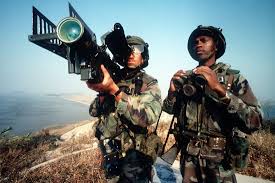Francis Tuschek, Staff Writer
Taiwan aims to boost its acquisition of Stinger missiles through US arms sales from 500 systems to 2,485, as reported by the Ministry of National Defense in a budget presentation to lawmakers.
The army plans to assume control of the Stinger program from the navy and modify the order to include an additional 1,985 missiles, along with 549 gripstock-control units and identification friend or foe (IFF) transponders, according to the document submitted to the legislature last week.
The delivery of these missiles is expected to be finalized by 2031.
台灣的國防部在向立法委員的預算報告中提到,計劃通過美國的軍售將其獲得的毒刺導彈數量從500套增至2,485套。
根據上週提交給立法院的文件,陸軍計劃接管毒刺計劃,並修改訂單以增加1,985枚導彈,以及549個手控單元和友敵識別(IFF)應答器。
這些導彈的交付預計將在2031年前完成。
The program’s budget is set to rise from NT$13.37 billion to NT$69 billion (approximately US$2.16 billion), according to reports.
The ministry noted that the US has approved modifications to the agreement.
Initially, the ministry planned to procure 250 missiles, 108 gripstocks, and 108 IFF transponders for the army, along with 250 missiles, 70 gripstocks, and 62 transponders for the navy. Subsequently, the navy added an order for 45 extra missiles, 15 gripstocks, and 15 transponders. It remains unclear whether the revised agreement incorporates these additional requests.
A defense official, speaking anonymously, explained that the ministry increased the order in response to escalating tensions in the Taiwan Strait.
The recent incursions into Taiwan’s air defense identification zone by the Chinese military highlight the urgent need for ground forces to enhance their air defense capabilities against aircraft and drones, the official remarked.
The FIM-92 Stinger, a short-range surface-to-air missile with a range of 4,800 meters, is typically operated by a two-person crew but can also be launched by a single operator.
The first delivery of Stinger missiles is scheduled for next year and will be allocated to the army and marine units, military police in Taipei, navy vessels, and coast guard garrisons in the Pratas Islands and Spratly Islands, according to the ministry.
The second batch, expected by 2031, will be kept in reserve, the ministry added.
根據報導,該計劃的預算將從133.7億新台幣增加到690億新台幣(約合21.6億美元)。
該部門指出,美方已批准對協議的修改。
最初,該部計劃為陸軍採購250枚導彈、108個發射架和108個IFF應答器,並為海軍採購250枚導彈、70個發射架和62個應答器。隨後,海軍新增了45枚導彈、15個發射架和15個應答器的訂單。目前尚不清楚修訂後的協議是否包含這些額外的要求。
一位匿名的國防官員解釋說,該部門增加訂單是因應台海緊張局勢的升高。
該官員表示,中國軍隊最近進入台灣空防識別區的行動凸顯了地面部隊加強對飛機和無人機的空防能力的迫切需求。
FIM-92刺針是一種射程為4800米的短程地對空導彈,通常由兩人組成的隊伍操作,但也可以由單一操作員發射。
根據該部門的說法,第一批刺針導彈的交付預定於明年,將分配給陸軍和海軍部隊、台北的軍事警察、海軍艦艇以及在澎湖列島和南沙群島的海巡隊駐地。
該部門補充說,第二批預計在2031年之前將被保留作為儲備。
The ministry reported that the air force is projected to spend a record NT$43.7 billion on maintenance and repairs next year to keep its aircraft and facilities operational. This amount represents a 16 percent increase from this year’s NT$36.8 billion and a 50 percent rise compared to last year.
The upcoming budget allocates NT$23.7 billion for acquiring spare parts for various aircraft, including fighter jets and cargo planes, as well as ground equipment, and NT$20 billion specifically for maintenance and repairs. Over the past eight years, the air force’s expenditures on maintaining weapons systems and facilities have surged by 224 percent.
Tensions have risen since Beijing began military flights around Taiwan after Tsai Ing-wen became president in 2016, escalating further following US House Speaker Nancy Pelosi’s visit to Taipei in 2022. In response to the need to monitor and intercept Chinese aircraft, the air force has increased its spending on airframe maintenance and has ordered 66 Lockheed-Martin F-16V jets, which the US is expected to deliver completely by 2026.
國防部報告指出,空軍預計明年在維護和修理方面的支出將創下新高,達到437億新台幣,以保持其飛機和設施的運營。這一數字比今年的368億新台幣增加了16%,與去年相比則增長了50%。
即將到來的預算中,為各型飛機(包括戰鬥機和貨機)以及地面設備的備件採購撥款237億新台幣,並專門撥款200億新台幣用於維護和修理。在過去八年中,空軍在維持武器系統和設施上的支出已經大幅上升了224%。
自2016年蔡英文就任總統以來,北京開始在台灣周邊進行軍事飛行,隨後在2022年美國眾議院議長南希·佩洛西訪問台北後,緊張局勢進一步升級。為了應對監控和攔截中國飛機的需求,空軍增加了在機身維護上的支出,並訂購了66架洛克希德·馬丁F-16V戰鬥機,預計美國將在2026年前全面交付。



